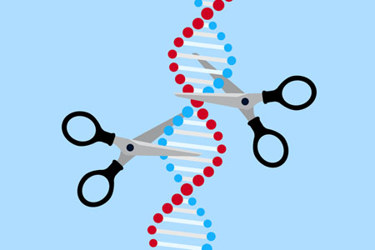Excision BioTherapeutics' CSO Discusses Dual-Guide RNA's Impact On Gene Editing

By Tyler Menichiello, Chief Editor, Bioprocess Online

Excision BioTherapeutics’ gene editing technology uses a novel dual-guide RNA (gRNA) approach to remove large sections of viral DNA in an effort to prevent viral replication and escape. To learn more about this technology and how it fits into the broader scope of gene editing, I met with Excision CSO, Dr. TJ Cradick.
The following Q & A has been edited for clarity and length.
Can you explain how Excision’s dual-guide RNA (gRNA) technology came to be?

When this paper was first published, Dr. Khalili immediately saw the potential to use the new CRISPR technology to remove or excise large sections of viral DNA. The CRISPR nucleases could be engineered to target viral DNA sequences with specific gRNAs. Khalili's lab later demonstrated that this dual gRNA approach was essential to deactivating viruses, and they highlighted this potential in a landmark Nature Communications paper, Dash et al., which showed the first cure of an animal infected with HIV.
Excision brought these two groundbreaking innovations together through IP and technology licenses from the Khalili Lab at Temple University’s Lewis Katz School of Medicine and the Doudna Lab at University of California, Berkeley (UC Berkeley). These technologies are now enabling us to discover and develop first-in-class therapeutics to cure chronic, viral infectious diseases.
What makes dual gRNA more effective or better than regular CRISPR Cas-9?
Multiple labs have now shown that a dual gRNA approach is essential to deactivate viral infections because two gRNAs are able to excise large sections of viral DNA. Single cuts in proviral DNA, regardless of the nuclease, have been unable to stop viral infections in animal models. Research studies on a variety of nucleases such as zinc fingers, meganucleases, and TALENs demonstrate their ability to remove one to 20 base pairs. However, a better approach is required to remove significant portions of viral genomes — often greater than 1,000 base pairs — to stop viral replication.
In order to excise this amount of proviral DNA, two or more cuts are necessary. The initial research was conducted on CRISPR Cas-9, but Excision has now generated data on new generations of CRISPR systems that can be even more effective than Cas-9. Specifically, Excision’s CRISPR license from UC Berkeley covers members of the Cas-12 family known as CasX and CasY.
Excision’s multi-guide (or multiplex) approach is incorporated in the company’s lead candidate, EBT-101, which was designed to cure HIV using this dual-guide approach to excise large portions of HIV proviral DNA. The product was designed to remove up to approximately 9,000 base pairs of the approximately 10,000 base pairs in the HIV genome.
What is the potential of dual gRNA?
Creating a safe, single-administration treatment for viral infectious diseases, which has the potential to transform and improve the lives of millions of individuals around the world. It offers the potential for people living with HIV to stop their therapies. Current HIV therapies can cause significant side effects.
In addition to targeting HIV, this type of treatment can save the vision of people facing potential blindness from infectious viruses, or potentially save the lives of individuals with terminal viral infections in the central nervous system (CNS). For all of these indications, Excision has quite a bit of work to do, but we strongly believe that with the current platform and published data, we have the tools to make this potential a reality.
One of the most fundamental advantages of Excision’s approach is the safety that can be designed into the system. Because viral genomes have dramatically different DNA sequences than human genomes, Excision scientists have spent years designing approaches and bioinformatic software to maximize “on-target” viral DNA cutting and minimize potential “off-target” cutting, or cuts in unintended locations. To date, Excision has not detected an off-target editing in any of its research on EBT-101.
How do you think this technology will impact the field of gene editing?
Excision’s approach could provide a series of advances in the field of gene editing. Excision is the first company to initiate a human clinical trial in the US with “multiplex” editing, meaning cuts in more than one location. Excision has recently received Fast Track Designation from the FDA for EBT-101 – a designation reserved for therapeutics to treat serious conditions with unmet medical needs, underscoring the importance of finding a cure for HIV.
Moreover, Excision has developed novel approaches and software to maximize the safety of gene editing. This includes a computational platform using extended modelling to identify the optimal target sites and assist with the sequencing studies to ensure specificity and help avoid off-target cuts.
How else can it be used? What other therapeutic areas are you considering, if any?
Excision has active development programs in HIV, Hepatitis B, Herpes Virus, and JC virus. However, there are numerous other applications that Excision could leverage with its approach that extend into oncology, neurology, and autoimmune diseases. We hope to expand into these new areas as the company grows.
What delivery vector do you use for this in vivo gene editing technique, and why?
Excision is agnostic to the type of delivery vector that can be used with its technology and approach. Instead, delivery strategy is driven by indication-specific targets. Excision uses the adeno-associated virus 9 (AAV9) as the delivery vector for its HIV program. Recently, Gene Therapy, a Springer Nature journal, published data showing that EBT-001 — a simian-specific analogue of EBT-101 that also used AAV9 — delivered gene editing machinery to each of the tissues that are known viral HIV reservoirs. In addition, EBT-001 demonstrated excision of simian immunodeficiency virus (SIV) DNA sequences in each of the tissues. The HIV program uses AAV9 because of its ability to reach these target tissues, such as the CNS.
Because other viruses target different tissues, Excision can use a variety of different vectors. The Excision team has considered and successfully tested multiple delivery approaches, such as viral vectors and lipid nanoparticles.
Are these vectors designed to target specific tissues?
Each delivery vector is specifically selected to target the infected tissues for each indication. Herpes Virus, for example, infects the peripheral nervous system ganglia, which may allow Excision’s therapeutic compounds to use viral or other delivery modalities.
There are many emerging technologies which target specific tissues. Excision expects to be able to leverage many of these as they are further proven to be safe and effective in multiple animal models and human clinical trials.
What do you predict for gene editing as we head into 2024? What are the industry’s biggest challenges to overcome?
We believe that gene editing will make significant advances in 2024 with proven human clinical data. Gene editing technologies, sequencing approaches, and detection methods are advancing rapidly from numerous labs and companies. We believe that additional data on the safety and efficacy of these approaches will catalyze even more activity and investment in the field. For example, we continue to see new methods for nominating potential off-target sites. As science and technology advances, we are seeing significant improvements in next-generation and long-read sequencing methods. The combination of improvements in bioinformatics and tissue culture nomination methods and sequencing have dramatically improved ours and the field’s ability to monitor for safety and efficacy.
There are currently several challenges in the gene therapy field such as the cost of manufacturing, storage, and shipping. For each of these challenges, there are numerous and varied innovations moving quickly to address them. New manufacturing approaches have generated exciting data to increase yields by an order of magnitude or more, as well as improved product efficacy, stability, and storage. New purification methods are demonstrating positive trends to increase the purity and yields versus currently used methods. The confluence of these innovations could transform gene therapies from a scarce therapeutic for rare diseases to much more common diseases with lower price points.
